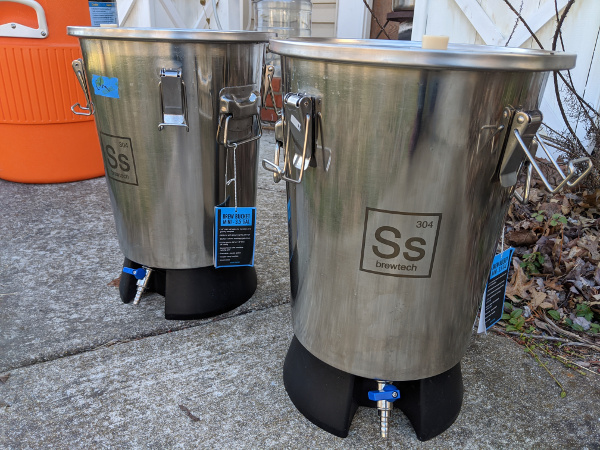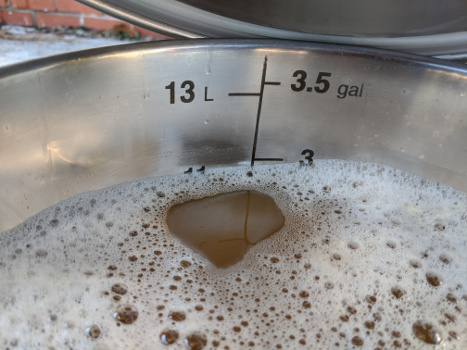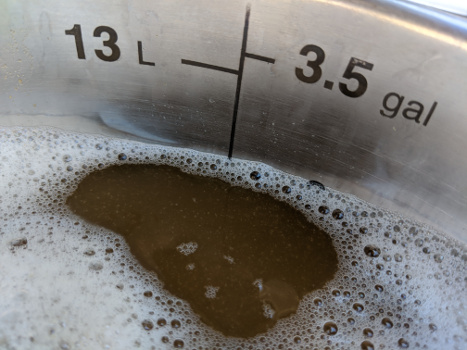
One of my brewing goals for 2020 is to improve the quality of my IPAs. I feel like this far into the brewing game, I should have a little more to show for it when I make my favorite style. They’re rarely bad, but they don’t wow as often as I’d like.
To that end I’m going to be doing a series of experiments this year where make two similar beers at the same time, with just one variable changed. I hope this will improve my process, one tweak at at time.
For this brew, I’m trying out some new hardware and techniques that I’ll use for the rest of my upcoming experiments.
What’s New?
Equipment
SS Brewtech 3.5 Gallon Brew Buckets
I can produce about 6 gallons of finished wort with my current kettle. Two 3.5 gallon fermenters are perfect for splitting one boil into two test batches.
Other nice features:
- Great at keeping out oxygen
- Small enough that I can fit both of them in my fermentation fridge at the same time
- The spigot + racking arm is very convenient
- Brew buckets are easy to clean
- I don’t have the right gas hardware yet, but I like that the brew buckets are capable of closed transfers under CO2.

80 Micron Mesh Bags
I’m a believer in keg hopping but I hate hop particles in finished beer.
I’ve tried many gadgets to fix this issue: 300 micron stainless steel hop tubes, 300 micron stainless steel mesh over the dip-tube, various mesh bags. I even spent $50 on a clear beer draught system. I wasn’t 100% satisfied with any of these.
I think I’ve finally found the solution though: 80 micron nylon mesh bags meant for making nut milk. These bags are great! They have a visibly finer weave than event the finest bags my local homebrew store sells, and they are 12"x12” giving lots of room for the hops to expand.
An issue I’ve had with dry hopping in bags is that the bags like to float. I bought some glass marbles to fix this. Marbles are good because they are cheap, inert, and can be sanitized.
A handful of marbles in the dry hop bag and they sink reliably.
Process
Lazy Brewer’s Split Batches
Many of the tests I want to run will have the same mash and boil parameters, differing only at the whirlpool or later. So to make life easy, I’m going to run almost all of my tests from a single mash and boil.
For changes like fermentation temperature, yeast variety, and dry hops it’s trivial to split from a single batch. Just brew as normal and transfer to two fermenters after chilling.
The novel half of my plan is that if I want to experiment with hot side hops, I’ll transfer half of the wort to a second kettle at flame-out which will let me add different whirlpool hops to each half. I’m going to try out that procedure with this first batch.
Sulfites at Packaging Time
Lately I’ve seen a lot of discussion about using low levels of sulfites to give antioxidant protection to oxygen sensitive beers, like NEIPAs. The dosage is very low, about 1/6th of a campden tablet in 5 gallons. I tried an A/B test in a recent bottled beer (Rye Barrel Old Ale) and noticed no ill effects so I’m going to be doing that for all my IPAs.
For one of these IPA tests I should make sulfites the test variable.
Low Oxygen Transfers
I don’t have the hardware to do a completely closed transfer yet, but I found some areas to improve my process and reduce oxygen exposure.
Previously I would sanitize a keg, purge it with a few blasts of CO2, then take the lid off my fermenter, open the lid of the keg and rack the beer in through the open lid.
My new process will be to purge all kegs by pushing out a full keg of sanitizer. This is more effective in removing Oxygen and uses less CO2 than repeatedly pressurizing and venting an empty keg.
Then to transfer the beer to the keg I will drain straight out of the brew bucket’s spigot and into the liquid post on the keg. To keep pressure from building, I’ll keep the keg’s relief valve open, but I won’t open the lid.
Recipe
Batch size: 6 gallons
Target OG: 1.055
Target FG: 1.011
Calculated IBU: 43.2
Calculated SRM: 4.8
Grain bill:
10.5lb US 2-Row (91.4%)
0.5lb Wheat Malt (4.3%)
0.5lb Honey Malt (4.3%)
Mash (Batch Sparge): 150 °F @ 1.4 qts/lb
Hops:
0.6 oz Warrior @ 60 minutes
Split in two 3 gallon halves at flame out
Half A (100% galaxy):
1.5 oz galaxy @ 15 minute hop stand (190 °F at start of hop stand)
1.5 oz galaxy @ Dry hop 72 hours into primary in weighted 80 micron bag
1.5 oz galaxy @ Keg hop in weighted 80 micron bag
Half B (2/3 galaxy, 1/3 citra):
1.0 oz galaxy / 0.5 citra @ 15 minute hop stand (190 °F at start of hop stand)
1.0 oz galaxy / 0.5 citra @ Dry hop 72 hours into primary in weighted 80 micron bag
1.0 oz galaxy / 0.5 citra @ Keg hop in weighted 80 micron bag
Yeast:
Most of a decanted 2L starter (stir plate) of Imperial A24 Dry Hop. Fermentation temp 67 °F
Notes
2020-03-07 - Brew day. Started the FO addition at about 190 °F. Got the split pretty even. The 100% galaxy half is maybe a pint lower than the galaxy/citra half.
OG 1.058. Next batch I should open the mill up a bit. It think it’s crushing too finely. Overshot the gravity and had a stuck sparge.


2020-03-10 - Added dry hops in new 80 micron hop bags weighted with some glass marbles.
2020-03-14 - Gravity: 1.011. Still seeing some airlock activity. I’ll give it a little longer before kegging
2020-03-17 - FG: 1.010. Purged the kegs by pushing out sanitizer with CO2, then quickly opened the lids and slipped the dry hops in before transferring. I added just the lightest dusting of metabisulfite in with the dry hops.
Left the kegs warm for about 4 hours and then into the kegerator to chill and carb at ~3x serving pressure.
2020-03-19 - Tapped. Both tasting really good! Will let it condition a bit before making comparisons and suggestions for next time.

2020-04-13 - Kicked the citra half. These have both been great. One of the best hoppy batches I’ve made to date.
They were very similar. Having one by itself, I couldn’t reliably say which one I was drinking. Side by side I had a slight preference for the citra blended half.
I wouldn’t rule out 100% galaxy again in the future though.
Changes for next time
I wouldn’t change much. It seems like all the process changes worked as planned. I think splitting batches at flame-out is going to be a great way to test different hop combinations.
My only complaint about this beer was that it was really really hazy. Next time I’m going to try dry hopping one day later in primary to see if I can reduce the haze a bit.
I’d also like to try increasing the whirlpool and dry hopping by 25% just to see if I notice an improvement. Somewhere down the line I’ll do a batch where the test variable is the hopping rate.